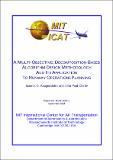A Multi-Objective, Decomposition-Based Algorithm Design Methodology and its Application to Runway Operations Planning
Author(s)
Anagnostakis, Ioannis; Clarke, John-Paul
DownloadICAT_Report_2004_5.pdf (4.363Mb)
Metadata
Show full item recordAbstract
Significant delays and resulting environmental impacts are commonly observed during departure
operations at major US and European airports. One approach for mitigating airport congestion
and delays is to exercise tactical operations planning and control with an objective to improve
the efficiency of surface and terminal area operations. As a subtask of planning airport surface
operations, this thesis presents a thorough study of the structure and properties of the Runway
Operations Planning (ROP) problem. Runway Operations Planning is a workload-intensive task
for controllers because airport operations involve many parameters, such as departure demand
level and timing that are typically characterized by a highly dynamic behavior. This research
work provides insight to the nature of this task, by analyzing the different parameters involved in
it and illuminating how they interact with each other and how they affect the main functions in
the problem of planning operations at the runway, such as departure runway throughput and
runway queuing delays. Analysis of the Runway Operations Planning problem revealed that
there is a parameter of the problem, namely the demand “weight class mix”, which: a) is more
“dominant” on the problem performance functions that other parameters, b) changes value much
slower than other parameters and c) its value is available earlier and with more certainty than the
value of other parameters. These observations enabled the parsing of the set of functions and the
set of parameters in subsets, so that the problem can be addressed sequentially in more than one
stage where different parameter subsets are treated in different stages. Thus, a decompositionbased
algorithm design technique was introduced and applied to the design of a heuristic
decomposed algorithm for solving the ROP problem. This decomposition methodology offers an
original paradigm potentially applicable to the design of solution algorithms for a class of
problems with functions and parameters that, similar to those of the ROP problem, can be parsed
in subsets. The potential merit in decomposing the ROP problem in two stages and the resulting
utility of the two-stage solution algorithm are evaluated by performing benefits analysis across
specific dimensions related to airport efficiency, as well as stability and robustness analysis of
the algorithm output.
Date issued
2004-09Series/Report no.
ICAT-2004-5
Keywords
Air transportation, Runway Operations